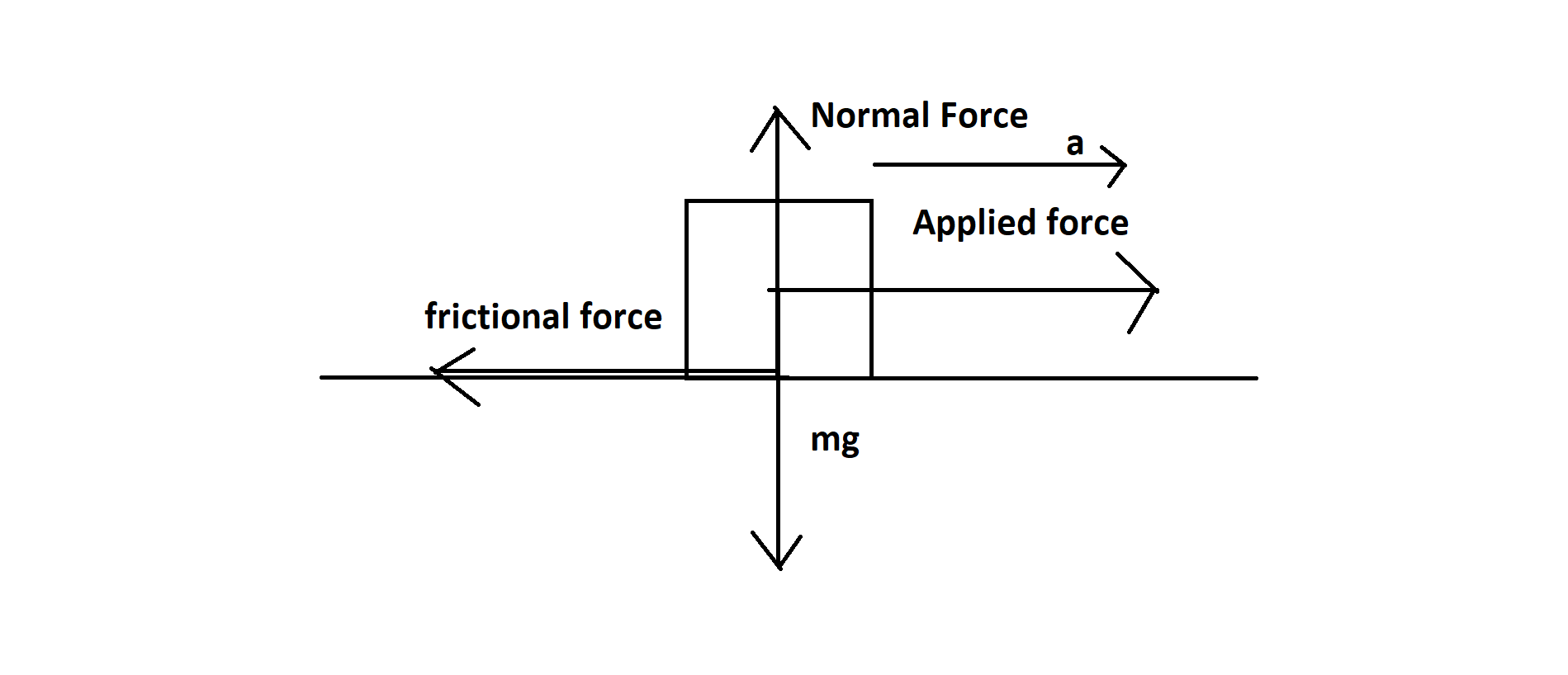
A block of mass 5 kg is on a rough horizontal surface and is at rest. Now a force of 24 N is imparted to it with negligible impulse. If the coefficient of kinetic friction is 0.4 and \[g{\text{ }} = {\text{ }}9.8\;m/{s^2}\], then the acceleration of the block is
Answer
219k+ views
Hint:
The coefficient of kinetic friction is a measure of how much resistance there is to sliding motion between two surfaces. The coefficient of kinetic friction is always less than or equal to the coefficient of static friction. Make a free body diagram of the body. Frictional force is given by $f = \mu N$ where N is the normal force and $\mu $coefficient of kinetic friction.
Complete step by step solution:
First see a picture of the scenario. Let's draw a free body diagram.

Here we are considering a body of mass m moving with an acceleration and frictional force opposing its motion. friction is a force that resists the sliding of two surfaces against each other. The frictional force is proportional to the normal force, which is the force that is perpendicular to the surfaces. The coefficient of friction, $\mu $, determines how much friction there is between the two surfaces. We can define friction as $f = \mu N$ where N is the normal. Normal force is the force exerted by a surface on an object in contact with it. This force is perpendicular to the surface and is responsible for keeping objects in contact with each other. Here we see that normal force is balanced by the weight of the body. That means $N = mg$ . so, we can also write $f = \mu mg$ . Now we can write the equation as $F - \mu mg = ma$ Here F is applied force. Now let’s put the values on the equation.
$F - \mu mg = ma$
$\begin{gathered}
{\text{or, }}24 - 0.4 \times 5 \times 9.8 = 5a \\
or,4.4 \div 5 = a \\
\end{gathered} $
$or,a = 0.88m{s^{ - 2}}$
Acceleration of the body is $0.88m{s^{ - 2}}$.
Note:
A force called friction prevents two surfaces from sliding against one another. The normal force, or the force that is perpendicular to the surfaces, is directly proportional to the frictional force and mathematically given by $f = \mu N$.
The coefficient of kinetic friction is a measure of how much resistance there is to sliding motion between two surfaces. The coefficient of kinetic friction is always less than or equal to the coefficient of static friction. Make a free body diagram of the body. Frictional force is given by $f = \mu N$ where N is the normal force and $\mu $coefficient of kinetic friction.
Complete step by step solution:
First see a picture of the scenario. Let's draw a free body diagram.

Here we are considering a body of mass m moving with an acceleration and frictional force opposing its motion. friction is a force that resists the sliding of two surfaces against each other. The frictional force is proportional to the normal force, which is the force that is perpendicular to the surfaces. The coefficient of friction, $\mu $, determines how much friction there is between the two surfaces. We can define friction as $f = \mu N$ where N is the normal. Normal force is the force exerted by a surface on an object in contact with it. This force is perpendicular to the surface and is responsible for keeping objects in contact with each other. Here we see that normal force is balanced by the weight of the body. That means $N = mg$ . so, we can also write $f = \mu mg$ . Now we can write the equation as $F - \mu mg = ma$ Here F is applied force. Now let’s put the values on the equation.
$F - \mu mg = ma$
$\begin{gathered}
{\text{or, }}24 - 0.4 \times 5 \times 9.8 = 5a \\
or,4.4 \div 5 = a \\
\end{gathered} $
$or,a = 0.88m{s^{ - 2}}$
Acceleration of the body is $0.88m{s^{ - 2}}$.
Note:
A force called friction prevents two surfaces from sliding against one another. The normal force, or the force that is perpendicular to the surfaces, is directly proportional to the frictional force and mathematically given by $f = \mu N$.
Recently Updated Pages
Two discs which are rotating about their respective class 11 physics JEE_Main

A ladder rests against a frictionless vertical wall class 11 physics JEE_Main

Two simple pendulums of lengths 1 m and 16 m respectively class 11 physics JEE_Main

The slopes of isothermal and adiabatic curves are related class 11 physics JEE_Main

A trolly falling freely on an inclined plane as shown class 11 physics JEE_Main

The masses M1 and M2M2 M1 are released from rest Using class 11 physics JEE_Main

Trending doubts
JEE Main 2026: Application Form Open, Exam Dates, Syllabus, Eligibility & Question Papers

Understanding Uniform Acceleration in Physics

Derivation of Equation of Trajectory Explained for Students

Hybridisation in Chemistry – Concept, Types & Applications

Understanding the Angle of Deviation in a Prism

Understanding Collisions: Types and Examples for Students

Other Pages
JEE Advanced Marks vs Ranks 2025: Understanding Category-wise Qualifying Marks and Previous Year Cut-offs

Units And Measurements Class 11 Physics Chapter 1 CBSE Notes - 2025-26

NCERT Solutions For Class 11 Physics Chapter 8 Mechanical Properties Of Solids

Motion in a Straight Line Class 11 Physics Chapter 2 CBSE Notes - 2025-26

NCERT Solutions for Class 11 Physics Chapter 7 Gravitation 2025-26

Understanding Atomic Structure for Beginners




